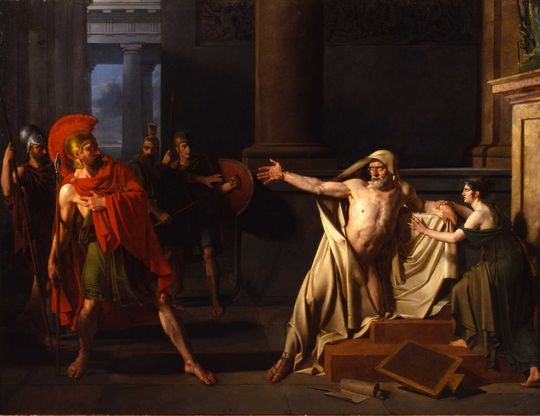THE DEATH OF DEMOSTHÈNE
1806

Oil on canvas
873-1-772
Bequeathed by Jean-Marie de Silguy in 1864
H. 113 cm - L. 145,5 cm
Drolling learns his art from his father and from David. A pure product of neoclassicism, he won the Grand Prix de Rome in 1810 with a painting called Achilles' Anger. He has mainly represented heroic and dramatic themes, but has also devoted himself to religious, decorative and portrait painting.
Drolling drew his inspiration from the book of the Greek writer Plutarch : Lives. This book tells the story of Demosthenes (384-322 BC), a great Athenian politician and orator, champion of the independence of Greece. Returning from exile, after the failure of his last attempt at insurrection against Alexander, Demosthenes retired to the temple of Poseidon located on the island of Calauria. He refuses to surrender to the army of Macedonian General Antipastros and prefers to kill himself. Drolling represents the crucial moment of Demosthenes' last harangue to the Thracian soldiers who came to arrest him, while he has already absorbed the deadly poison.
This theme of "exemplum virtutis" or patriotic sacrifice is one of the most popular in the neoclassical movement.
THE DEATH OF DEMOSTHÈNE
1806

Oil on canvas
873-1-772
Bequeathed by Jean-Marie de Silguy in 1864
H. 113 cm - L. 145,5 cm
Drolling learns his art from his father and from David. A pure product of neoclassicism, he won the Grand Prix de Rome in 1810 with a painting called Achilles' Anger. He has mainly represented heroic and dramatic themes, but has also devoted himself to religious, decorative and portrait painting.
Drolling drew his inspiration from the book of the Greek writer Plutarch : Lives. This book tells the story of Demosthenes (384-322 BC), a great Athenian politician and orator, champion of the independence of Greece. Returning from exile, after the failure of his last attempt at insurrection against Alexander, Demosthenes retired to the temple of Poseidon located on the island of Calauria. He refuses to surrender to the army of Macedonian General Antipastros and prefers to kill himself. Drolling represents the crucial moment of Demosthenes' last harangue to the Thracian soldiers who came to arrest him, while he has already absorbed the deadly poison.
This theme of "exemplum virtutis" or patriotic sacrifice is one of the most popular in the neoclassical movement.
